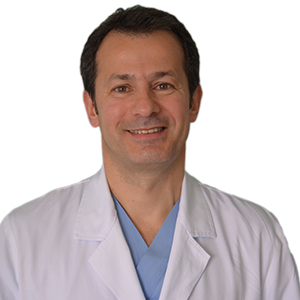
In the future there will be more TEVAR procedures performed as use of the procedure continues to rise and as it becomes available in smaller centres. The evolution of stent graft design is likely to reduce complications, writes Santi Trimarchi, San Donato Milanese, Italy.
Data from the International Registry of Acute Aortic Dissection (IRAD) has shown that about 55% of acute type B aortic dissections are uncomplicated, with a low in-hospital mortality of 6.1%, compared to 20% in complicated acute type B dissections. The initial treatment of uncomplicated acute type B aortic dissections consists of optimal medical treatment, i.e. tight heart rate and blood pressure control. Despite promising initial results, with an in-hospital survival of 90–98%, a substantial portion (20–50%) of uncomplicated acute type B aortic dissection patients will develop aortic enlargement with subsequent risk of rupture and other complications, even with optimal medical treatment. Therefore, a debate is ongoing regarding whether a more aggressive approach should be adopted for the uncomplicated acute type B aortic dissection patients to prevent aortic enlargement and its related complications.
This discussion has led to some trials comparing optimal medical treatment to optimal medical treatment plus thoracic endovascular repair (TEVAR), in uncomplicated acute type B aortic dissection patients. These trials, such as INSTEAD and ADSORB, failed to show improved short-term outcomes for TEVAR in terms of survival; however, they did show a benefit for TEVAR for long-term survival and aortic remodelling. These studies conclude that there might be evidence to adopt TEVAR also in presence of uncomplicated cases. Does this mean that all uncomplicated acute type B aortic dissection patients require invasive treatment? The answer to this question remains unclear, because the mentioned trials lack statistical power, and criticism directed at them includes that: they were underpowered, with limited follow-up in one of the cases, with unclear inclusion criteria in another one, and the fact that both were industry-sponsored trials.
Indisputably, TEVAR allows for earlier and more rapid aortic remodelling since the primary entry tear is covered, but it is not without risks, since endovascular treatment is associated with complications including aortic rupture, retrograde dissection and stent graft-related complications such as endoleaks. Due to this, a conservative approach in many patients is still advocated. Furthermore, it is important to note that unpublished IRAD data show about 15% of initially uncomplicated acute type B aortic dissections develop in-hospital complications, meaning that about 85% of the patients leave hospital without complications. So certainly, in the acute phase, it seems unjustified to treat all uncomplicated acute type B aortic dissections.
In general, the correct time to perform TEVAR appears to be in the subacute phase (between 15–90 days) as showed by the VIRTUE trial. To prove that TEVAR is indeed safe in uncomplicated acute type B aortic dissection patients and that it provides a clear benefit over optimal medical treatment, new and larger randomised controlled trials should be conducted comparing TEVAR to optimal medical treatment. Additionally, studies attempting to predict which uncomplicated acute type B aortic dissection patients are at risk of aortic enlargement are needed also. If this can be predicted, a more aggressive approach might be justified in these patients. Currently, several clinical predictors of aortic enlargement in acute type B aortic dissections have been identified, such as connective tissue disorders and Caucasian race. On the contrary, older patients and Asian patients tend to show less enlargement. Furthermore, radiological factors such as false lumen diameter >22mm, total aortic diameter >40mm, patent false lumen, partial false lumen thrombosis, circular false lumen configuration and a saccular false lumen have been associated with aortic enlargement. In addition, entry tear dimensions >10mm seem to result in increased aortic dilation, as well as a single entry tear which has been reported as being associated with higher growth rates compared to patients with multiple entry tears.
All of these predictors are not specific for uncomplicated acute type B aortic dissections, but they can be used to identify the patients at high risk and also the patients that might never need an intervention, i.e. the truly uncomplicated acute type B aortic dissection patients. New imaging techniques are making their way into clinical practice, aiding risk-assessment in acute type B aortic dissection patients. These techniques, such as 4D-MRI, ECG-gated computed tomography angiography and computational fluid dynamics, do not only focus on the aortic diameter, but make it possible to visualise also flow and pressure in the aorta and its side branches. This could prove to be an important development, since it is now commonly accepted that higher pressures, as well as blood flow in the false lumen, play important roles in the development of aortic enlargement and rupture.
Surely, in the future, more TEVAR procedures will be performed as its use continues to rise and TEVAR becomes available also in smaller centres. Furthermore, evolution of stent graft design will probably reduce the number of stent graft-related complications, since the current grafts have not been tailor-made for the fragile aorta of dissection patients. Nevertheless, actually, the choice of treatment for uncomplicated acute type B aortic dissection, optimal medical treatment or optimal medical treatment plus TEVAR, should be made on an individual basis after careful risk assessment based on age, clinical and radiological risk factors, and predictors of outcome.
Santi Trimarchi is associate professor of Vascular Surgery, University of Milan, Cardiovascular Department, Policlinico San Donato IRCCS, director, Thoracic Aortic Research Center, San Donato Milanese, Italy.













